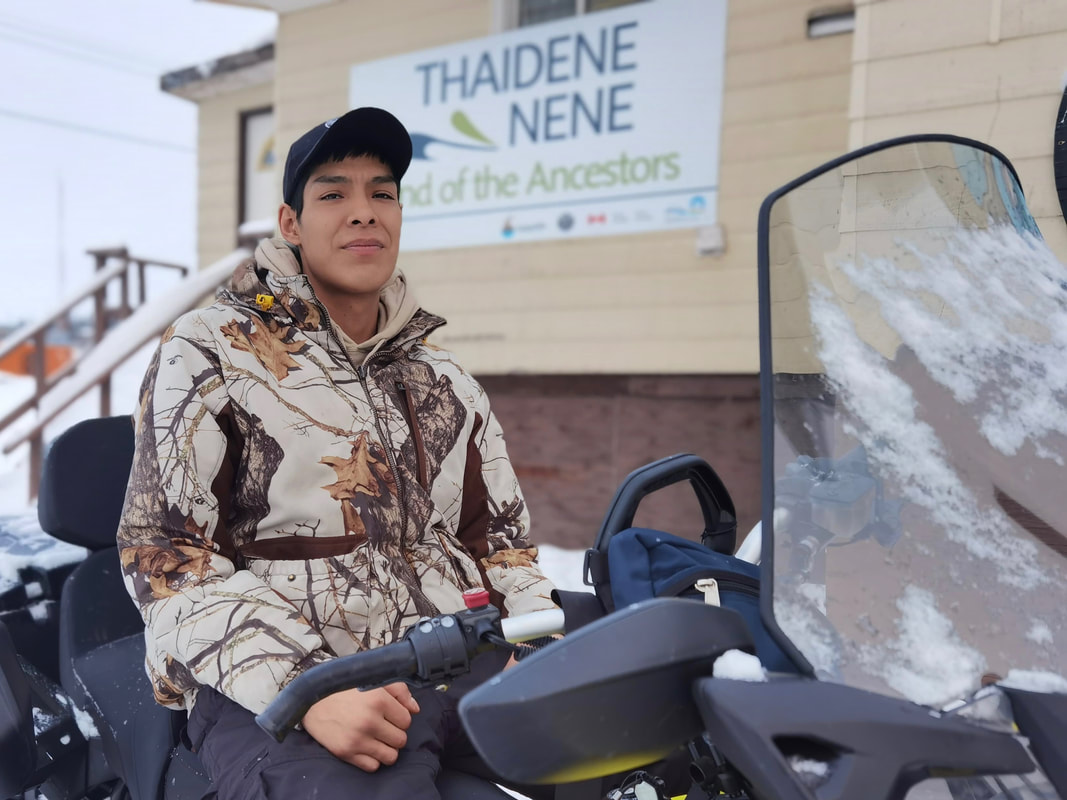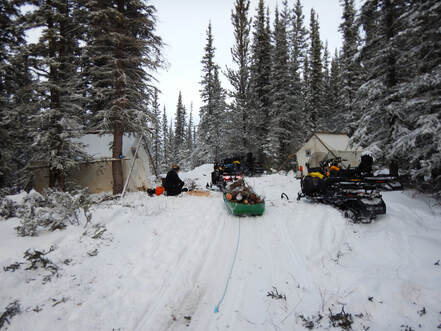 Thaidene Nëné and the Łutsël K’é Dene First Nation are the subject of the season finale of BirdNote's new podcast, Threatened. Threatened offers sound-rich stories about the enduring connections between birds, people, and landscapes. Listen as community members Iris Catholique, Florence Catholique, Shonto Catholique, and Steve Nitah introduce the world to the Land of the Ancestors. In addition to allowing for the continuation of the Dënesųłıné way of life, the Thaidene Nëné Indigenous Protected Area, which was designated by the community in 2019 and which includes a national park reserve, a territorial protected area, and soon a wildlife conservation area, is that it conserves critical habitat for billions of birds. 6.5 million acres of critical habitat to be exact! You can listen to the episode here. You can also subscribe to Threatened on: Or through your favorite podcast app. This is the third in a series of profiles about the staff, leaders, and community members who are hard at work implementing Łutsël K’é Dene First Nation's vision for the Thaidene Nëné Indigenous Protected Area. You can read the other profiles here.  Like the other Ni Hat’ni Dene guardians, Denecho Catholique feels pretty lucky to be part of the crew: “I get to do what I love, which is travel on the land.” Two of Denecho’s favourite places to visit in Thaidene Nëné are Kaché (Fort Reliance) and Pike’s Portage. The latter is a special trail for Łutsël K’é Dene that crosses the treeline, connecting Kache to ɂedacho Kúe (Artillery Lake). “It’s a different country up there,” Denecho explains, referring to the barrenlands, or hazú in Dënesųłıné. As part of the Ni Hat’ni Dene crew, Denecho is also able to visit places in his ancestral territory he’s never been to. In the spring of 2020, for instance, the guardians travelled to Tł’ombálı Tué (Tent Lake), the place where his father was raised. This experience was especially meaningful because Denecho was able to travel there with his dad, Herman Catholique, and Herman hadn’t been to Tł’ombálı Tué in 40 years. As Denecho visits places both familiar and new in Thaidene Nëné with Ni Hat’ni Dene, he is honing his skills as a land user. In particular, he notes, “I’ve learned how to travel and navigate better.” Before he was hired as a junior guardian in January 2020, Denecho worked with Ni Hadi Xa (People Watching the Land Together), the environmental monitoring program for Gahcho Kué Diamond Mine. While he enjoyed being a monitor, the position with Ni Hat’ni Dene has allow Denecho to be closer to his family, including his twin daughters, McKinley and Tthaili. Both girls love spending time on the land with their dad, whether they are going out on the big lake or visiting with their grandma, Irene Catholique, at her place on the Snowdrift River. Denecho is more than a role model for his daughters. In his words, “As a Ni Hat’ni Dene guardian, I am a role model for the younger generations. That makes me feels good. It makes me feel special.” Whether he’s teaching local youth traditional practices, informing visitors about how to travel respectfully in Thaidene Nëné, keeping an eye on important cultural and historic sites, or assisting with fire fighting, Denecho is proud to be a watcher of the land, a Ni Hat’ni Dene. This is the second in a series of profiles about the staff, leaders, and community members who are hard at work implementing Łutsël K’é Dene First Nation's vision for the Thaidene Nëné Indigenous Protected Area. You can read the other profiles here. Being hired as a junior guardian with Ni Hat’ni Dene was a dream come true for Chase Lockhart: “I really like to go out on the land. I like hunting, fishing, camping, trapping.” Born and raised in Łutsël K’é, Chase’s love for the land comes from spending time out with his family, but especially his grandparents, Joe and Bernadette Lockhart. In addition to passing on the skills needed to survive in the bush, Bernadette and Joe taught young Chase the value of respect and helping others. They also modelled the importance of taking care of your things and yourself. In addition to the opportunity to spend time on the land, Chase enjoys the variety of the role: “It’s always different what we are doing,” he explains. “I like getting new ideas.” Travelling with others beyond his immediate family has been an important part of Chase’s education over the last year: “Everyone has their own skills, style, techniques, and teachings. I’m learning from the community.” When asked about his favourite places in Thaidene Nëné, Chase responded, “The whole lake, the East Arm, the tundra.” So all of Thaidene Nëné really, though he did make a special mention of Tł’ombálı Tué (Tent Lake), which Ni Hat’ni Dene visited in the spring as part of their caribou monitoring program. “It was my first time in a long time seeing big herds of caribou like that,” he remembers fondly. In addition to caring for the land and welcoming visitors to Thaidene Nëné, Chase is a role model for young people in Łutsël K’é, a part of the junior guardian job description that he loves and takes seriously. “Some people are losing their ways. They’re not going out. I’m showing them that it’s easy to go out and that this can be a job that you do if you go out and know your teachings.” Chase is the youngest of the current Ni Hat’ni Dene crew, but he has big ambitions. He wants to continue to hone his skills as a land user and pass on what he knows to the younger generations; the guardians are often called up to teach traditional skills as part of youth on-the-land programs. He also wants to learn his language, a goal that is perhaps best achieved on the land, the source of Dënesųłıné. Blog Categories Getting set up at the Old Snowdrift OTL Camp. More photos below. Getting set up at the Old Snowdrift OTL Camp. More photos below. Łutsël K’é Dene First Nation's Thaidene Nëné Department has partnered with the Wellness, Language, and Culture Department to establish and host an on the land camp for LKDFN residents of all ages to enjoy. Youth from the Łutsël K’é Dene School, elders, and other land users are invited to come to the “Old Snowdrift OTL Camp.” Participants will be engaged for on the land programming and research. Land-based activities will include: teaching youth how to set snares and traps, skinning animals, setting fish nets under the ice, fish preparation, ice safety and safe travelling on the land. We will share the harvest with local elders. The Ni Hat'ni Dene guardians and traditional instructors will be on site to help mentor and teach Dënesųłıné culture and language. The camp is also an opportunity to complete a research survey, the results of which will help guide the Thaidene Nëné Department in management planning for the future of Thaidene Nëné. All completed surveys will be compiled and a report with your recommendations will be prepared for the LDKFN Chief and Council. Your input is important and we welcome you to take the survey. A honorarium of $60 is payable to each survey participant. Please note: you can only complete the survey once. The survey is available for download as a Microsoft Word document. There is also an online version of the survey. Transportation will be provided to and from the site from December 3 – 18, 2020. Snacks and brunch will be provided daily for all participants. To sign up for transportation and/or to learn more about this exciting on the land project, contact the Thaidene Nëné Manager at 867-370-3820 or drop by our Thaidene Nëné Office. Interested participants can also contact the Wellness Manager at 867-444-8055. |
AuthorWrite something about yourself. No need to be fancy, just an overview. Archives
July 2024
Categories |
CONNECT |
VISIONWe are the Lutsel K’e Dene First Nation. Our vision for Thaidene Nëné is:
Nuwe néné, nuwe ch'anıé yunedhé xa (Our land, our culture for the future). We’re working with our partners to permanently protect Thaidene Nëné—part of our huge and bountiful homeland around and beyond the East Arm of Tu Nedhé. |
